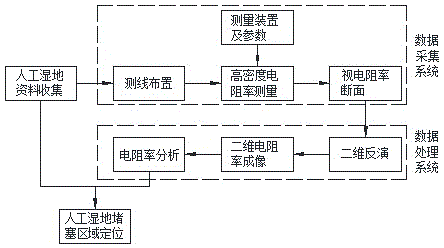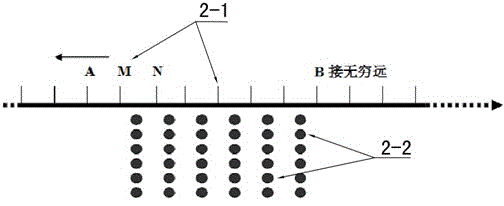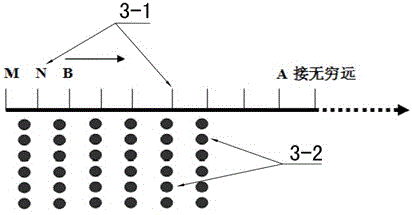Method for positioning constructed wetland blocked area on basis of two-dimensional resistivity imaging technology
A technology of resistivity imaging and constructed wetlands, applied in electric/magnetic exploration, acoustic re-radiation, geophysical measurement, etc.
- Summary
- Abstract
- Description
- Claims
- Application Information
AI Technical Summary
Problems solved by technology
Method used
Image
Examples
Embodiment 1
[0030] Two-dimensional resistivity imaging technology of constructed wetlands without clogging.
[0031] The process of locating the clogged area of constructed wetland based on two-dimensional resistivity imaging technology is as follows: figure 1 As shown, on the basis of collecting and analyzing the existing data of the constructed wetland, reasonably arrange the measuring line and set the acquisition parameters, and obtain the apparent resistivity section under the measuring line through the high-density resistivity measurement method; then the collected apparent resistivity Perform two-dimensional inversion of the section, convert the apparent resistivity data into resistivity data, and draw the contour map of the resistivity section to realize two-dimensional resistivity imaging; finally, by analyzing the two-dimensional resistivity imaging section, the detection of artificial Purpose of wetland clogged areas.
[0032] The specific steps are:
[0033] (1) Surveying l...
Embodiment 2
[0039] Two-dimensional resistivity imaging of constructed wetlands with clogged regions.
[0040] The detection and analysis process of this embodiment is as follows figure 1 .
[0041] The specific steps are:
[0042] (1) Surveying line layout: Arrange high-density surveying lines above the constructed wetland with a distance of 50cm between surveying lines and 10cm between measuring points. .
[0043] (2) AMN device measurement: First, arrange the three-pole positive device AMN device (such as figure 2 ), the negative pole B of the power supply is connected to the "infinity" pole, and the electrode arrangement adopts a "rectangular AMN" device; when measuring, M and N in 2-1 do not move, and A moves to the left point by point to obtain a rolling line. Then A, M, and N move one electrode to the right at the same time, M, and N do not move, and A moves to the left point by point again to get another rolling line, so that the rolling measurement continues to get an apparen...
PUM
| Property | Measurement | Unit |
|---|---|---|
| Resistivity | aaaaa | aaaaa |
Abstract
Description
Claims
Application Information
 Login to View More
Login to View More - R&D
- Intellectual Property
- Life Sciences
- Materials
- Tech Scout
- Unparalleled Data Quality
- Higher Quality Content
- 60% Fewer Hallucinations
Browse by: Latest US Patents, China's latest patents, Technical Efficacy Thesaurus, Application Domain, Technology Topic, Popular Technical Reports.
© 2025 PatSnap. All rights reserved.Legal|Privacy policy|Modern Slavery Act Transparency Statement|Sitemap|About US| Contact US: help@patsnap.com



